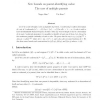Free Online Productivity Tools
i2Speak
i2Symbol
i2OCR
iTex2Img
iWeb2Print
iWeb2Shot
i2Type
iPdf2Split
iPdf2Merge
i2Bopomofo
i2Arabic
i2Style
i2Image
i2PDF
iLatex2Rtf
Sci2ools
CPC
2004
2004
New Bounds on Parent-Identifying Codes: The Case of Multiple Parents
Let C be a code of length n over an alphabet of q letters. A codeword y is called a descendant of a set of t codewords {x1 , . . . , xt } if yi {x1 i , . . . , xt i} for all i = 1, . . . , n. A code is said to have the Identifiable Parent Property of order t if for any word of length n that is a descendant of at most t codewords (parents), it is possible to identify at least one of them. Let ft(n, q) be the maximum possible cardinality of such a code. We prove that for any t, n, q, (c1(t)q) n s(t) < ft(n, q) < c2(t)q n s(t) where s(t) = ( t 2 + 1)2 - 1 and c1(t), c2(t) are some functions of t. We also show some bounds and constructions for f3(5, q), f3(6, q), and ft(n, q) when n < s(t).
| Added | 17 Dec 2010 |
| Updated | 17 Dec 2010 |
| Type | Journal |
| Year | 2004 |
| Where | CPC |
| Authors | Noga Alon, Uri Stav |
Comments (0)

